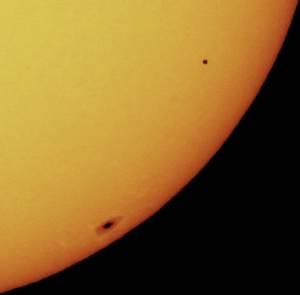|
…now what about ET?
Astronomers
are searching the galaxy for exoplanets — planets orbiting other stars —
hoping to find any that might support life. So far, they haven’t found
alien life, but they have found over 4000 exoplanets, primarily via the transit method — detecting the tiny dimming of light from a star when one of its planets passes through our line of sight.
This
image shows Mercury (small dot, upper right) transiting the Sun, as
seen from Earth, with a sunspot in the lower left. Transits are very
difficult to detect, but we have become good at it.

When
a transiting exoplanet is found, the next step is analyzing its
atmosphere for signs of life, the presence of molecules of organic
origin, such as O2. Since oxygen molecules are highly reactive, O2
cannot be abundant without a continuous source, for which life is the
most probable candidate. We are still learning how to analyze exoplanet
atmospheres — no great discoveries yet.
Since
we are searching for ET by looking for transits of distant stars,
perhaps ET is searching for us by looking for Earth transiting our star.
Astrophysicists
L. Kaltenegger of the Carl Sagan Institute of Cornell University and J.
K. Faherty of the American Museum of Natural History in New York
authored a paper identifying ETZ (Earth Transit Zone) stars, stars from
which Earth was/is/will be viewable transiting our Sun, at any time from
3000 BC to 7000 AD.
People
once thought stars were “fixed” in the sky. Actually, all stars are in
constant motion, although it’s rarely detectable without sophisticated
instruments. The ESA’s (European Space Agency) Gaia satellite is now
measuring the positions and motions of billions of stars. We can now
determine which stars were/are/will be in the ETZ, near enough to the
plane of Earth’s orbit and close enough to detect an Earth transit.
The
authors find 2034 ETZ stars within 326 light-years. Of these, 313 were
once, 319 will be, and 1402 are in positions to see Earth transits. Of
ETZ stars, 194 are G-type stars like our Sun, while most are much less
hospitable, including 1520 M dwarfs, 109 white dwarfs, and 12 red
giants.
Additionally,
46 of the ETZ stars are, and 42 will be, within 100 light-years of
Earth, close enough to potentially detect our radio transmissions, which
began about 100 years ago (S. G. Marconi, 1922). These 46 stars, which
include 3 G-type stars, can now see Earth transits and detect our radio
emissions.
Seven
of the 2034 ETZ stars are known to host exoplanets, and four of those
are within 100 light-years — more details in the footnote.
The
authors note that Earth’s atmosphere has had abundant oxygen — a
compelling sign of life — for a billion years. Extrapolating from their
10-millennia calculations, they estimate ETs in millions of star systems
could have already detected an inviting Earth.
To
paraphrase Nobel Laureate Enrico Fermi: “So, where are they?” —
meaning, if there are so many ETs, why haven’t they visited or even
called?
FOOTNOTE: More about the nearest ETZ stars.
Ross128
is about 11 light-years away, with one Earth-size exoplanet. It entered
and exited the ETZ 3057 and 900 years ago, respectively.
Teegarden
is 12 light-years away, with two exoplanets of about Earth’s mass. It
will enter the ETZ in 2050 AD and exit 410 years later.
GJ9066 is 15 light-years away, with one exoplanet. It will enter the ETZ 846 years from now and exit 932 years later.
Trappist-1
is 41 light-years away, with 7 Earth-size exoplanets. It will enter the
ETZ 1642 years from now and exit 2371 years later.
Best Wishes,
Robert

March 2022
Note: Previous newsletters can be found on my website.
|